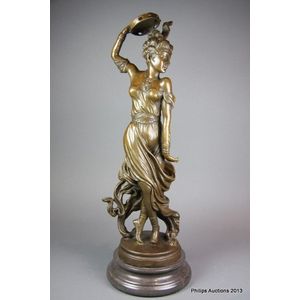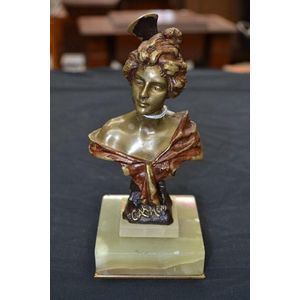Art Nouveau Maiden Bust on Onyx Plinth
You must be a subscriber, and be logged in to view price and dealer details.
Subscribe Now to view actual auction price for this item
When you subscribe, you have the option of setting the currency in which to display prices to $Au, $US, $NZ or Stg.
- Bronze - An alloy of copper and tin, traditionally in the proportions of about 9 parts of copper to 1 part of tin.
The discovery of bronze in Western Asia in the 4th century enabled people to create metal objects which were superior to those previoulsy possible because of its strength and hardness, and it has been used throughout the world for weapons, coins, tools, statuary and other decorative items.
It is very fluid in a molten state, and its hardness, strength when set, and non-corrosive properties makes it most suitable for casting sculpture. - Art Nouveau Period - The Art Nouveau period was a cultural movement that emerged in the late 19th century, and was characterized by its emphasis on natural forms, flowing lines, and a decorative, ornamental style. Art Nouveau was a reaction against the ornate and heavily stylized designs of the previous era, and sought to create a new, more organic aesthetic.
Art Nouveau was characterized by its use of sinuous, curving lines, as well as a focus on natural elements such as flowers, vines, and other organic shapes. Art Nouveau designers sought to create a total work of art, in which every element of a building or object was designed to be harmonious with the overall design.
Some of the most iconic examples of Art Nouveau design include the Paris Metro entrances designed by Hector Guimard, the works of the artist Alphonse Mucha, and the architecture of Victor Horta in Brussels.
The Art Nouveau period was at its peak between 1890 and 1910, but began to decline in popularity by the start of World War I. However, Art Nouveau remains an important influence on design and art to this day, and continues to be celebrated for its emphasis on natural forms and decorative style. - Onyx - Onyx is a form of agate, used from antiquity and popular again in the 1920s and 30s. European onyx is generally green, but can be many other colours, and can contain bands of black and/or white.
This multicoloured stone is widely used for table tops, lamp bases and in jewellery. Some types of onyx are also used for cameos of which the upper white layer is cut away to reveal the colour beneath. - Cold Painted - This is term applied to so-called "Vienna bronzes" manufactured in that city starting in late part of the 19th century, and it continued in the early 20th century, but was also used by sculptors working in other areas of Europe at the time..
Traditionally bronzes are finished by treating them with various acids and chemicals and heats, and the patina is incorporated into the surface of the piece.
A cold-painted bronze is decorated with oil paints. The color was not fired, hence the term "cold painted". Reputedly the painting was carried out mainly by women working at home, a typical cottage industry.
This item has been included into following indexes:
Visually similar items

A fine pair of dwarf gilded candlesticks, circa 1860; by William Hutton & Son, in the neoclassical style with urn form sockets, and raised upon pedestal square bases, with removable drip pans, embellished with running bead pattern, gadrooning, swags and pa

Art Deco amber glass scent bottle

Moreau, Auguste (1834-1917), After, an exotic female dancer, bronze, modelled in motion, in flowing robes and holding a tambourine above her head, on an integral base with incised signature and cast foundry mark, on a moulded stone plinth. Height 56 cm (ov

French twin figured mantel clock, on rouge marble base with cherub decoration, the figures supporting the globe clock. Height 65 cm
